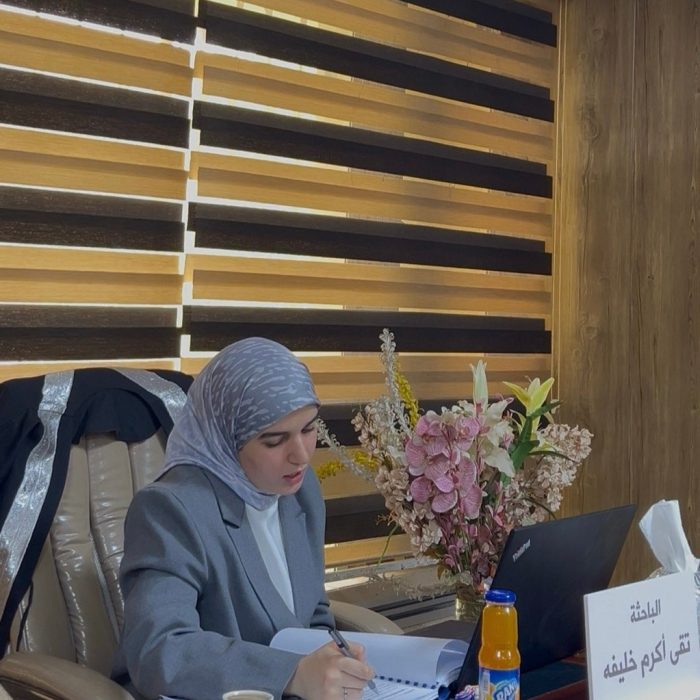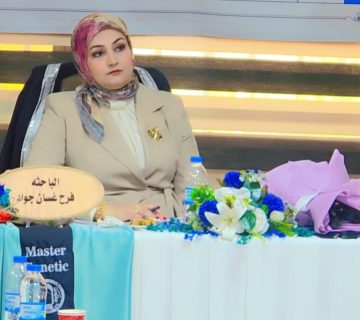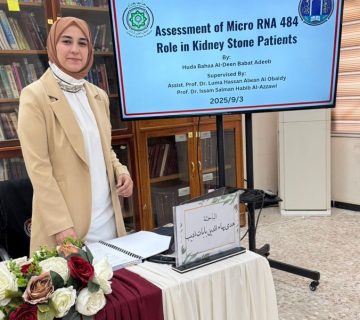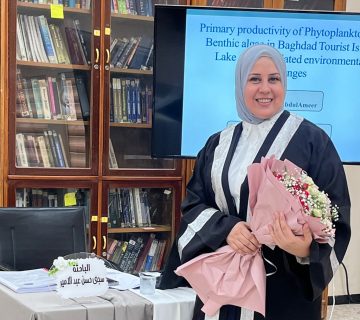Thesis Discussion
The master’s thesis, “Hybrid Synthesis of Metal Oxide Nanoparticles via (Ultrasonic and Pulsed Laser) and Their Biomedical Applications”
” was the topic of discussion at the College of Science for women at the University of Baghdad.
Student: Tuqa Akram Khaleefah
The objective of the study is to synthesize PtO₂ and CdO nanoparticles using a hybrid method that combines pulsed laser and ultrasound techniques, aiming to enhance the efficiency of the produced nanoparticles. The study also focuses on examining the structural, crystallographic, optical, and electrochemical properties of these metal oxide nanoparticles. Additionally, the research aims to evaluate their antimicrobial activity against Streptococcus mutans and Candida albicans, the main pathogens involved in dental caries, assess their ability to inhibit biofilm formation on various surfaces, and determine their antioxidant potential.
This study was conducted at the University of Baghdad, College of Science for Women, Department of Physics, while the experimental work was carried out in the Biotechnology Laboratory at the College of Science, Baghdad. The research involved the synthesis of PtO₂ and CdO nanoparticles using a hybrid technique combining pulsed laser ablation with ultrasonic probe in deionized water. The nanoparticles were prepared at two different laser wavelengths (532 nm and 1064 nm), and characterized using various analytical techniques, including X-ray diffraction (XRD), field emission scanning electron microscopy (FE-SEM), energy-dispersive X-ray spectroscopy (EDX), atomic force microscopy (AFM), UV-Vis spectroscopy, laser-induced breakdown spectroscopy (LIBS), and zeta potential measurements. The biological activity of the synthesized nanoparticles was evaluated against Streptococcus mutans and Candida albicans, focusing on their antibacterial, antifungal, antibiofilm, and antioxidant properties.
The most important recommendations which the study has come up with and the average obtained:
- Preparation of another metallic nanoparticles by pulsed laser ablation technique with the possibility of changing the laser parameters such as energy, number of pulses, and repetition rate.
- Preparation of nanoparticles using pulsed laser ablation and comparison with ultrasonic-assisted pulsed laser ablation, along with the study of their effect on Streptococcus mutans.
- Using other types of pulsed lasers, such as excimer and CO₂ lasers, to prepare metallic nanoparticles and investigate their physical properties.
- Evaluating the antibacterial effects of various types of nanoparticles, such as copper nanoparticles, on Streptococcus mutans.
Excellent grade.










